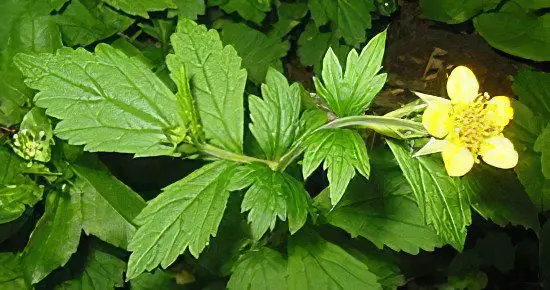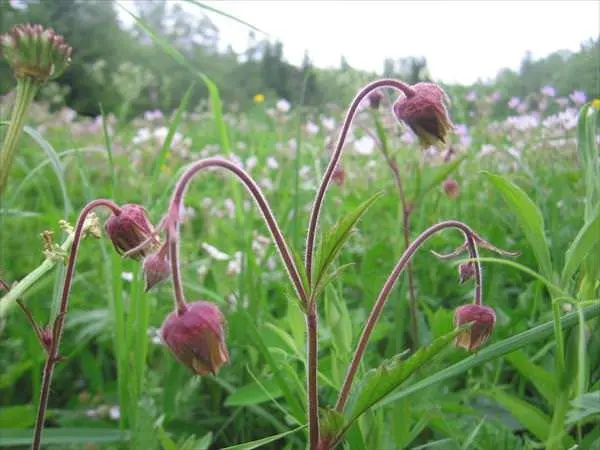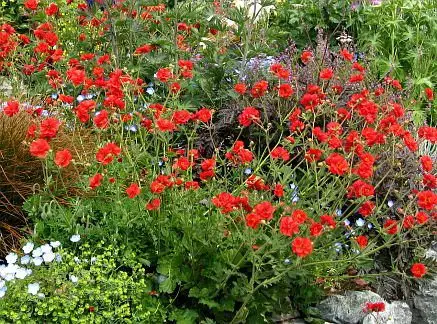Contents
Useful properties and application of gravilate
Botanical characteristics of urban gravilate

Gravilite city is a perennial herbaceous plant of the Rosaceae family. The dark-colored stem can reach a length of 130 cm (the length of the stem depends on environmental conditions).
A characteristic feature of this medicinal plant is the presence of a thick rhizome, painted in a bright brown color. Basal leaves grow together at the base of the plant and form a rosette. Single, rather large flowers are painted in light yellow color. The fruit is a multi-nutlet of a spherical shape (pubescent). The flowering time of the urban gravilata falls on the period from May to October.
The natural distribution area of urban gravilate is the European part of Russia, Ukraine, Belarus, Western Siberia and Central Asia. This medicinal plant grows almost everywhere.
Useful properties of gravel
Medicinal properties are possessed by both the above-ground and underground parts of the medicinal plant. Harvesting of medicinal raw materials occurs at the beginning of flowering (this is the end of May). The rhizomes are dried in the air, the aerial part is dried in a ventilated and protected from direct sunlight.
In its chemical composition, urban gravilate contains tannins and bitter substances, essential oil, resin, glycoside and starch. The therapeutic infusion and decoction of gravilate have a pronounced tonic, tonic, diaphoretic, expectorant, hemostatic, anti-inflammatory, wound healing, antiseptic and astringent effect.
The use of gravilate
Unlike traditional, folk medicine, all the therapeutic effects that the infusion and decoction of urban gravilate have on all sorts of diseases of various organs and organ systems have been appreciated.
Gravilat urban flowers are used for diseases of viral etiology, kidney disease, various gastrointestinal diseases (colitis, vomiting, flatulence, intestinal colic).
The aerial part is used for cough, diarrhea, colitis, gastritis, cholecystitis and malaria. In the form of a powder, medicinal raw materials are used topically as a wound healing agent.
The underground part (rhizome) is used for dry, barking cough, diseases of the kidneys, liver, various diseases of the gastrointestinal tract, such as gastritis, colitis, flatulence.
Infusion of urban gravilate: 10 g of crushed medicinal raw materials are placed in a thermos and pour 200 ml of boiling water. Infuse the remedy for two hours, after which the infusion is used orally 1/4 cup 3 times a day.
A decoction of urban gravilate (aerial parts): 20 g of medicinal raw materials are poured into 250 ml of boiling water and placed in a boiling water bath for 30 minutes. The resulting broth is cooled, filtered and used 1 tablespoon (15 ml) 3 times a day.
A decoction of urban gravilate (underground part): 15 g of crushed medicinal raw materials are poured into 200 ml of boiling water and put in a boiling water bath for 30 minutes. The resulting broth is cooled and filtered into a clean container. Apply the product in a warm form, 1 tablespoon (15 ml) 3-4 times a day.
River gravel

River gravel is a perennial herbaceous plant of the Rosaceae family. The erect pubescent stem can reach a height of 75 cm. A characteristic feature of the medicinal plant is the presence of a brown creeping root. The flowers are bells (drooping), the calyx is red-brown, the corolla is light yellow or light pink. The fruit is a combined achene with a hook at the end. The river gravilate blooms from May to June, the fruits ripen in July-August.
The natural range of river beetle is the European part of Russia (northern and middle regions), eastern and western regions of Siberia, the Caucasus. Place of growth – damp slightly acidic soils, swampy places, shores of lakes, rivers and reservoirs.
Medicinal raw materials are both the above-ground part of the plant (flowers and grass) and the underground (root). In its chemical composition, river gravilate root contains tannins, carbohydrates, resins, starch, tannins and bitter substances, glycosides, organic acids and essential oils (clove oil). In the fresh leaves of the medicinal plant, a high concentration of ascorbic acid (vitamin C) and carotene was found.
Due to the unique chemical composition, river gravilate has found wide application in folk medicine. Healing infusions and decoctions, as well as dry powder from the root of a medicinal plant, have such properties as anti-inflammatory, wound healing, hemostatic, antiseptic, antimicrobial, tonic, antacid, diaphoretic and anthelmintic.
The use of medicinal infusion and decoction of river gravilate is indicated for such diseases as hemorrhoidal and uterine bleeding, allergies, malaria, diseases of the gastrointestinal tract (accompanied by high acidity), inflammatory diseases of the kidneys, gallbladder, nervous disorders, rheumatism.
Externally, a decoction of gravilate is used in dentistry for stomatitis, laryngitis and periodontal disease.
The powder of the crushed root of river gravilate is used for ulcers of various etiologies and purulent wounds.
Infusion of herb gravilata river: to prepare an infusion, 1 tablespoon of medicinal raw materials is poured into 400 ml of boiling water and left for 2 hours, after which it is filtered and taken warm 3 times a day, 1/3 cup.
Infusion of river gravel root (option No. 1): to prepare the infusion, 2 teaspoons of the crushed root are poured into 200 ml of boiling water and infused for 1 hour in a sealed container, after which it is filtered and taken 1 tablespoon (15 ml) 3 times a day.
Infusion of river gravel root (option No. 2): to prepare the infusion, 2 teaspoons of the crushed root are poured into 100 ml of boiling water and left for 1 hour in a tightly closed container, after which the resulting infusion is filtered and taken 1 tablespoon 3 times a day before meals.
A decoction of the root of river gravel (option No. 1): to prepare a decoction, 2 tablespoons of chopped root are poured into 400 ml of boiling water, put in a boiling water bath for 10 minutes, then cooled for 1 hour (without removing it from the water bath). The resulting decoction is filtered and applied topically for inflammatory diseases of the oral cavity, as well as for joint and muscle pain.
A decoction of the root of river gravel (option No. 2): 6 g of dry medicinal raw materials are poured into 400 ml of boiling water, after which they are placed in a boiling water bath for 30 minutes. The broth is filtered (hot) into a clean container and the resulting volume of the broth is adjusted with purified water to 400 ml. The remedy is taken 3 times a day, 2-3 tablespoons.
Powder of river gravilate root: a dry root of crushed medicinal raw materials is placed in a wooden mortar and thoroughly ground. Take orally 0,1 g 3 times a day.
Perennial gravel
Gravilat perennial is a perennial herbaceous plant of the Rosaceae family. A characteristic feature of perennial gravel is the presence of a creeping root, painted in brown-red color.
The erect pubescent stem reaches a height of 50 cm (depending on environmental conditions). Stem leaves are three- and five-lobed. Flowers solitary, large, light yellow. The flowering period of perennial gravel is May-June. The fruit is a combined achene, the seeds end with a small hook.
The natural range of perennial gravel is the European part of Russia, Ukraine, Belarus and the territory of Western Siberia.
Medicinal raw materials are both the above-ground part of the plant (stem, flowers) and its underground part (root with rhizome). The young leaves of perennial gravilat contain ascorbic acid, carotene and tannins. The roots and rhizomes of a medicinal plant contain glycoside, tannins, bitter substances, essential oil, starch and resins in their chemical composition.
Gravilat perennial has a number of medicinal properties that are used with great success in traditional medicine. Medicinal infusions and decoctions have anti-inflammatory, hemostatic, wound healing, analgesic, astringent and antiseptic effects.
Gravilat Chilean

Chilean gravel is a perennial herbaceous plant of the Rosaceae family. The erect stem reaches a height of 60 cm. A characteristic feature of the Chilean gravel is the presence of bright red, almost scarlet flowers with a diameter of about 3 cm. The flowers are collected in a paniculate inflorescence. The leaves are pinnate, collected in a basal rosette. Blooms Chilean gravel from late June to mid-August.
The natural range of the Chilean gravilate is South America (Chile).
This medicinal plant has long been used in traditional medicine by the Indians living in Chile.
Healing infusions and decoctions have analgesic, anti-inflammatory and tonic effects. They are used for toothache, inflammatory diseases of the genitourinary system (including prostatitis in men and menstrual irregularities in women) and inflammatory processes of the gastrointestinal tract.
Gravity red
Gravilat red is a perennial herbaceous plant of the Rosaceae family. An upright pubescent stem can reach a height of 30 cm. The flowers are large, reach 3–4 cm in diameter, and can be colored from yellow-orange to red. The flowers are collected in few-flowered inflorescences. Gravilat red blooms from late May to late June.
The natural range is Greece, Asia Minor, the Balkans and the Caucasus.
In nature, gravilate red is rare. Infusions and decoctions from this plant do not have any healing properties, therefore, they are not used in medicine (traditional and folk). Gravilat red today is an unpretentious garden form.
Terry gravel
Terry gravel is a perennial herbaceous plant. The pubescent stem reaches a height of 60 cm. Single double flowers can be painted golden yellow or bright red (scarlet). Terry gravel blooms from June to August.
Infusions and decoctions of terry gravilate do not have any therapeutic effect, therefore they are planted exclusively for decorative purposes.
gravilate root
Gravilat root has a number of healing properties that are successfully used in traditional medicine. You can harvest medicinal raw materials twice a year – either in late autumn or early spring. The root is cleaned, cut into small pieces and dried at a temperature of 45 ° C in a ventilated room.
In its composition, the gravilate root contains a number of useful substances, such as essential oils, resins, bitter substances, tannins, glycosides.
The use of infusion and decoction of gravilate root has anti-inflammatory, hemostatic, expectorant, choleretic, antiemetic, wound healing, analgesic and antitumor effects.
Gravilat root is indicated for such diseases as diarrhea, vomiting, flatulence, dysentery, gastritis (with low acidity), uterine and hemorrhoidal bleeding, biliary dyskinesia, bronchitis, bronchial asthma.
Gravity Flowers
Gravilat is a perennial plant of the Rosaceae family. In total, 50 types of gravel are found in nature, which grow on different continents and, accordingly, in different climatic conditions. One of the characteristic differences of one type of gravel from another is the shape and color of the flower.
Depending on the type of gravel, flowers can be painted in white, pink, yellow and red. Petals can be either wide open or gathered into a bell (drooping). Flowers can be either single or collected in paniculate or umbellate inflorescences (from 3 to 10 pieces). There is a variety of hybrid beetle, which was obtained by crossing red beetle and Chilean beetle.
Gravity cultivation
Gravilat is a perennial herbaceous plant, unpretentious to environmental conditions. It usually blooms from May to July. A number of species of gravel can bloom throughout the summer period from June to August (hybrids).
A well-lit place is best for the best growth of gravel, but light partial shade is also allowed. Despite the fact that the plant is frost-resistant, it is best to cover the bushes of the plant for the winter period, especially for hybrid types of gravel.
The plant is rarely exposed to various diseases and insect attacks. Perennial gravel loves abundant watering, but the plant should not be over-watered. River gravel feels great in wetlands, so it can be planted in areas with high humidity (pond, artificial reservoir).
During flowering, gravilate requires the timely removal of dry flowers.
Seeds are sown at the beginning of spring, and ready-made seedlings – at the end of April (the beginning of the warm season).
Reproduction of the plant is carried out either by seeds (in the spring) or by dividing the bushes (in the spring and autumn).
Contraindications to the use of gravilat
To date, no contraindications to the use of gravilat have been identified. However, it must be borne in mind that preparations based on it can contribute to blood clotting, therefore, their long-term use is highly discouraged for people suffering from increased thrombosis. It should also be used with caution in patients with low blood pressure and prone to constipation.









